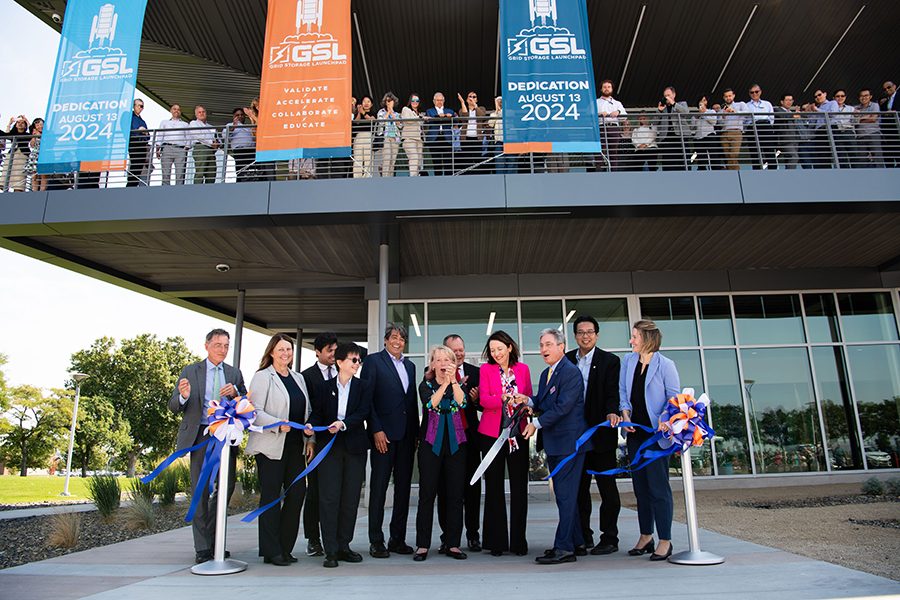
Home » New $75M facility to power energy storage research
New $75M facility to power energy storage research

Officials cut the ribbon for Pacific Northwest National Laboratory's new Grid Storage Launchpad Aug. 13. The facility will help accelerate clean energy solutions.
Courtesy Andrea Starr | Pacific Northwest National LaboratoryAugust 16, 2024
Officials celebrated an important milestone in clean energy production in the Tri-Cities: the dedication of a new facility at Pacific Northwest National Laboratory.
The Grid Storage Launchpad, called GSL, was first announced in early 2021 but has been in the works for nearly a decade, officials said during the event.
An enthusiastic crowd that included elected officials, scientists and community leaders gathered Aug. 13 under a large white tent outside the $75 million facility in Richland. They spoke about how the GSL will help advance clean energy initiatives.
U.S. Sen. Maria Cantwell said that although “wind and solar may be the cheapest forms of electricity, it’s not always windy and sunny … grid storage needs to be there to fill the gap.”
The GSL will accelerate clean energy solutions through its focus on battery technologies.
The facility was funded by the Department of Energy’s Office of Electricity and built in partnership with the Office of Science. The state of Washington provided $8.3 million for GSL’s equipment.
At 93,000 square feet, the launchpad will house 30 laboratories and 100 researchers.
Gene Rodrigues, associate secretary for the Office of Energy, said that the ribbon cutting means the facility is officially “open for business, and they’re getting ready to start taking in innovators and inventors and chemists and everybody else to work together on some key issues that face us.”
Storage solutions
The launchpad will allow researchers “to explore new approaches to energy storage and test them at scale, from fundamental materials discovery to 100-kilowatt scale battery systems,” said Steve Ashby, director of PNNL, during the ribbon-cutting festivities.
Rodrigues said that the GSL is “purpose built” to address the challenges in “validating new storage technologies.”
The validation portion includes applying existing battery technology in new ways, testing technologies developed by innovators in “rigorous real-world conditions,” and developing new approaches and technologies, he said.
One of those research paths is coming up with new materials to use in energy storage. The materials currently used to store energy “are not abundant and not necessarily cheap,” Rodrigues said. GSL allows researchers to test different and more abundant materials.
The GSL also serves as a hub for collaboration, “bringing together the folks who are creating new ideas from the private sector, putting them together with the researchers of our nation’s national labs … and they work together to come up with the most cutting-edge solutions and accelerate them,” Rodrigues said.
Part of the GSL’s role is also in “educating the future energy storage workforce,” said Ashby, noting that “hundreds of interns and postdocs will begin their professional journeys at the GSL.”

Gene Rodrigues, above, spoke at the dedication ceremony of the Grid Storage Launchpad at PNNL.
| Andrea Starr | Pacific Northwest National LaboratoryNeighboring facilities
Ashby said the GSL complements the other facilities at PNNL. “These include the Energy Sciences Center next door and the Electricity Infrastructure Operations Center across the street,” he said.
Harriet Kung, acting director of the Office of Science and deputy director for science programs, also emphasized the presence of GSL’s neighboring facilities.
“With the Grid Storage Launchpad located just next door to the Office of Science facilities, the physical proximity of these world class facilities and capabilities on the PNNL campus will further the magnification of the innovation cycle,” she said.
“Right next to each other are the building that does basic research … next to the lab that’s about innovation with the private sector and the public sector,” Rodrigues said. He described this as the proximity between basic and applied science, “science that’s taken to the real world to make a difference.”
Mission-driven
Making a difference is what makes GSL truly important, Rodrigues said.
“When people come to work to try to make a giant difference in the world, it’s a lot different than just coming to work to test stuff,” he said.
GSL’s mission drives its work. Researchers are testing technology under real conditions, assuring the safety of energy storage technology, and making that technology “affordable and accessible to all,” Rodrigues said.
The development of energy storage solutions is “critical to enhancing grid resiliency and realizing our shared vision for a clean energy future,” Ashby said during the opening event.
Geri Richmond, DOE under secretary for science and innovation, stressed the importance of storage capacity in underserved communities.
“It’s also important for us to remember that whatever we do, whether it be in energy storage or anything else that we do, reaches every part of this country, every person in this country,” she said.
“This facility has been a dream in the making for almost a decade,” said Julie Turner, manager of DOE’s Pacific Northwest site office.
As exciting as it is for the launchpad to officially open, “the most exciting part is what’s going to happen tomorrow and the day after tomorrow and the day after that,” Rodrigues said.
Latest News Energy Science & Technology
KEYWORDS August 2024
Related Articles
Related Products





